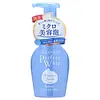What's inside
What's inside
 Key Ingredients
Key Ingredients

 Benefits
Benefits

 Concerns
Concerns

 Ingredients Side-by-side
Ingredients Side-by-side

Water
Skin ConditioningSorbitol
HumectantGlycerin
HumectantDipropylene Glycol
HumectantButylene Glycol
HumectantSodium Methyltaurate
Skin ConditioningLauryl Betaine
CleansingLauric Acid
CleansingArginine Cocoate
Skin ConditioningPolyquaternium-7
Sodium Acetylated Hyaluronate
HumectantSodium Hyaluronate
HumectantSericin
Skin ConditioningMyristic Acid
CleansingPentasodium Pentetate
Sodium Metabisulfite
AntioxidantPotassium Hydroxide
BufferingBis-Ethoxydiglycol Cyclohexane 1,4-Dicarboxylate
EmollientCitric Acid
BufferingPotassium Sorbate
PreservativeTocopherol
AntioxidantSodium Benzoate
MaskingParfum
MaskingWater, Sorbitol, Glycerin, Dipropylene Glycol, Butylene Glycol, Sodium Methyltaurate, Lauryl Betaine, Lauric Acid, Arginine Cocoate, Polyquaternium-7, Sodium Acetylated Hyaluronate, Sodium Hyaluronate, Sericin, Myristic Acid, Pentasodium Pentetate, Sodium Metabisulfite, Potassium Hydroxide, Bis-Ethoxydiglycol Cyclohexane 1,4-Dicarboxylate, Citric Acid, Potassium Sorbate, Tocopherol, Sodium Benzoate, Parfum
Ingredients Explained
These ingredients are found in both products.
Ingredients higher up in an ingredient list are typically present in a larger amount.
Citric Acid is an alpha hydroxy acid (AHA) naturally found in citrus fruits like oranges, lemons, and limes.
Like other AHAs, citric acid can exfoliate skin by breaking down the bonds that hold dead skin cells together. This helps reveal smoother and brighter skin underneath.
However, this exfoliating effect only happens at high concentrations (20%) which can be hard to find in cosmetic products.
Due to this, citric acid is usually included in small amounts as a pH adjuster. This helps keep products slightly more acidic and compatible with skin's natural pH.
In skincare formulas, citric acid can:
While it can provide some skin benefits, research shows lactic acid and glycolic acid are generally more effective and less irritating exfoliants.
Most citric acid used in skincare today is made by fermenting sugars (usually from molasses). This synthetic version is identical to the natural citrus form but easier to stabilize and use in formulations.
Read more about some other popular AHA's here:
Learn more about Citric AcidDipropylene Glycol is a synthetically created humectant, stabilizer, and solvent.
This ingredient helps:
Dipropylene glycol is technically an alcohol, but it belongs to the glycol family (often considered part of the ‘good’ alcohols). This means it is hydrating and gentle on skin unlike drying solvent alcohols like denatured alcohol.
As a masking agent, Dipropylene Glycol can be used to cover the smell of other ingredients. However, it does not have a scent.
Studies show Dipropylene Glycol is considered safe to use in skincare.
Learn more about Dipropylene GlycolLauric Acid is a fatty acid or lipid. About half of fatty acids in coconut oil is lauric acid.
This ingredient helps hydrate and sooth skin. As a humectant, it helps trap moisture. It also aids in cleaning and enhancing the texture of products.
Lauric acid may not be Malassezia folliculitis, or fungal acne, safe.
Learn more about Lauric AcidWater. It's the most common cosmetic ingredient of all. You'll usually see it at the top of ingredient lists, meaning that it makes up the largest part of the product.
So why is it so popular? Water most often acts as a solvent - this means that it helps dissolve other ingredients into the formulation.
You'll also recognize water as that liquid we all need to stay alive. If you see this, drink a glass of water. Stay hydrated!
Learn more about Water